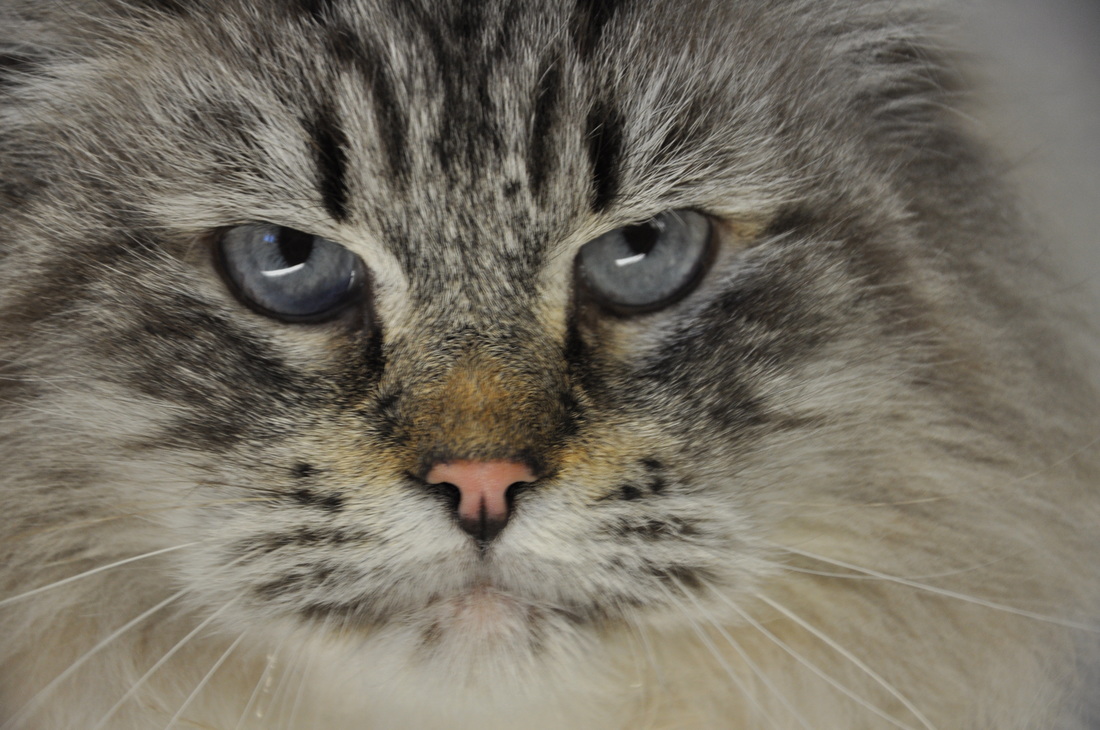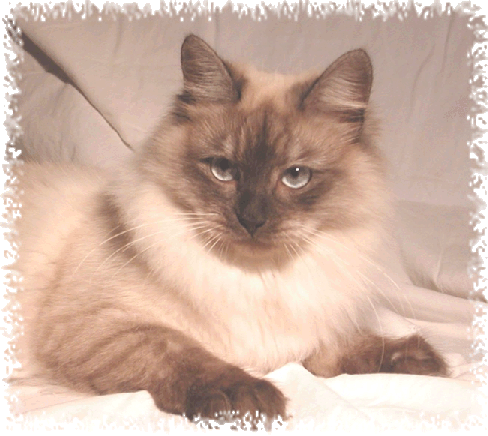Le Neva masquerade est une variante de couleur du chat sibérien. Les Sibériens colorpoints sont apparus en même temps que les Sibériens à couleurs traditionnelles (brown tabby, silver tabby, red tabby, etc.). Les premiers chats Sibériens étaient en fait des chats des rues et quelques passionnés ont décidé d'établir un standard et de faire un programme d'élevage de ce chat là. Tous les chats de rues n'entraient pas dans la catégorie "sibériens".
Tout d'abord les croisements avec des Persans colorpoints et / ou des chats sacrés de Birmanie ne sont pas possibles. Pourquoi, tout simplement parce que le premier Persan colorpoint a été importé en Russie en 1991 et les Birmans sont arrivés encore plus tard alors que la race et la couleur « point » du chat Sibérien était déjà inscrite au standard depuis 1990. Cela signifie par ailleurs, que ces chats là existaient avant 1990, donc dans les années 80.
Pour savoir pourquoi les colorpoints sont apparus dans cette race et non chez le Norvégien ou le Maine coon est simple. Pourquoi une telle diversité dans les couleurs chez le chat Sibérien ?
Cela s'explique de façon historique. En effet, après la seconde guerre mondiale dans la région de St Petersbourg (Russie), il ne restait plus beaucoup de chats dans la ville. Par contre, souris et rats proliféraient. C'est pourquoi, des centaines de chats ont été attrapés dans toute la Russie puis envoyés à St Petersbourg. Parmi ces nombreux chats, il devait y avoir des colorpoints mélangés avec d'autres couleurs. C'est donc une race naturelle riche en couleur !
C'est pour ces raisons que le chat Sibérien colorpoint appelé Neva Masquerade a été admis au même titre que les autres couleurs dites traditionnelles.
Tout d'abord les croisements avec des Persans colorpoints et / ou des chats sacrés de Birmanie ne sont pas possibles. Pourquoi, tout simplement parce que le premier Persan colorpoint a été importé en Russie en 1991 et les Birmans sont arrivés encore plus tard alors que la race et la couleur « point » du chat Sibérien était déjà inscrite au standard depuis 1990. Cela signifie par ailleurs, que ces chats là existaient avant 1990, donc dans les années 80.
Pour savoir pourquoi les colorpoints sont apparus dans cette race et non chez le Norvégien ou le Maine coon est simple. Pourquoi une telle diversité dans les couleurs chez le chat Sibérien ?
Cela s'explique de façon historique. En effet, après la seconde guerre mondiale dans la région de St Petersbourg (Russie), il ne restait plus beaucoup de chats dans la ville. Par contre, souris et rats proliféraient. C'est pourquoi, des centaines de chats ont été attrapés dans toute la Russie puis envoyés à St Petersbourg. Parmi ces nombreux chats, il devait y avoir des colorpoints mélangés avec d'autres couleurs. C'est donc une race naturelle riche en couleur !
C'est pour ces raisons que le chat Sibérien colorpoint appelé Neva Masquerade a été admis au même titre que les autres couleurs dites traditionnelles.
Cooncreole Nikkolas, seal tabby point
Il ne faudrait pas séparer les Neva masquerade du chat Sibérien, les standards sont les mêmes. De plus, ce serait nuisible pour la race et parce q'un type doit toujours être renforcé et donc dans la logique des choses, chacun doit travailler avec les meilleurs sujets et cela dans toutes les couleurs.
Avec l'aimable collaboration d'Irina Sadovnikova, WCF, Russie.
Voici un compte-rendu d'éleveurs, juges et représentant de la World Cat Federation qui a eu lieu à Moscou le 12 décembre 2001 qui traite du Sibérien Neva Masquerade :
On 6.12.2001 a meeting of judges, breeders and other representatives of cat fanciers took place in Moscow. The meeting was called on the initiative of the International Committee of Cat Judges. Among those present (35 people) were:
Mrs. Olga Abramova, WCF Int.Judge
Mrs. Inna Shustrova, WCF Int.Judge
Mrs. Larisa Ovchinnikova, WCF Int.Judge
Mrs. Olga Mironova, SFF judge
Mr. Alexey Stchukin, TICA/WCF judge
Mr. Vladimir Nechaev, chief editor of "Drug", Russian cat fancy magazine
Mrs. Tatiana Pavlova, Union of Siberian Cat Fanciers.
Breeders representing the following catteries:
Veschiy Son, Losinyi Ostrov, White Night, de Gleimur, Adagio, Zhemchug Nevy.
Representatives of cat fanciers clubs from Moscow, Omsk and Tomsk.
The questions discussed were the origin and development of aboriginal Russian cat breeds, the type and breeding of Siberian cats including Neva Masquerade. The reason for the meeting were the efforts of some breeders and judges to separate the colourpoint from the Siberian breed.
As a result of the heated discussion the following resolution was carried :
Copyright Jan. 2002
Irina Sadovnikova
Avec l'aimable collaboration d'Irina Sadovnikova, WCF, Russie.
Voici un compte-rendu d'éleveurs, juges et représentant de la World Cat Federation qui a eu lieu à Moscou le 12 décembre 2001 qui traite du Sibérien Neva Masquerade :
On 6.12.2001 a meeting of judges, breeders and other representatives of cat fanciers took place in Moscow. The meeting was called on the initiative of the International Committee of Cat Judges. Among those present (35 people) were:
Mrs. Olga Abramova, WCF Int.Judge
Mrs. Inna Shustrova, WCF Int.Judge
Mrs. Larisa Ovchinnikova, WCF Int.Judge
Mrs. Olga Mironova, SFF judge
Mr. Alexey Stchukin, TICA/WCF judge
Mr. Vladimir Nechaev, chief editor of "Drug", Russian cat fancy magazine
Mrs. Tatiana Pavlova, Union of Siberian Cat Fanciers.
Breeders representing the following catteries:
Veschiy Son, Losinyi Ostrov, White Night, de Gleimur, Adagio, Zhemchug Nevy.
Representatives of cat fanciers clubs from Moscow, Omsk and Tomsk.
The questions discussed were the origin and development of aboriginal Russian cat breeds, the type and breeding of Siberian cats including Neva Masquerade. The reason for the meeting were the efforts of some breeders and judges to separate the colourpoint from the Siberian breed.
As a result of the heated discussion the following resolution was carried :
- All the breed-forming features of the Nevas are equal to those of Siberians. That's why it is considered to be pointless to register the Nevas as a new breed. Neva Masquerades are Siberian colourpoints, and as such, they are bred together with other colours of Siberian cats and shown as Siberian cats according to the show rules (divided in groups according to sex, age and colour). It is desirable and sensible to cross Siberians and Nevas.
- One should gradually try to set limits to using non-pedigree Siberian phenotype cats, including colourpoints. A total banning of novice cats is not reasonable on the recent stage of breed development. The novice class should be open for them for at least 5 years.
- The judges are recommended to be stricter to all signs of Persian or Balinese outcrossing in all colours of Siberian cats in order to exclude such cats from breeding.
- The correct type is considered to be the main feature. The coat should correspond to the standard in every colour, but one should take into consideration that agouti cats always have the most characteristic coat.
- A darkened body, tabby markings or spots on the flanks and belly are not a reason for penalizing, as it is characteristic of aboriginal cats that presumably had in their history crosses with wild cats. Moreover, aboriginal Russian cats still often have access to outdoors in summer.
- Breeders and judges should consider if it is necessary to distinguish between different types of tabby in Nevas, as in colourpoints tabby patterns are blurred and indistinct, and the cat can be penalized for lack of clarity in the pattern.
- The contrast between the points and the body stays a requirement of the standard.
Copyright Jan. 2002
Irina Sadovnikova
Faïna, seal smoke point
Toute reproduction, même partielle, par quelque procédé que ce soit, est interdite sans autorisation préalable.

